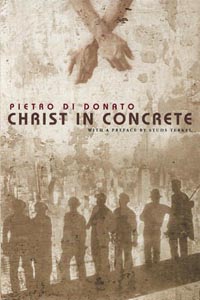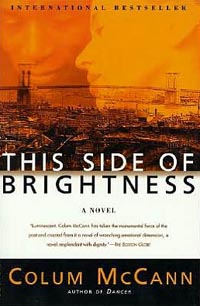 CHRIST IN CONCRETE by Pietro Di Donato BUY THIS BOOK |
Here are two novels of the building trades: one by an Italian-American bricklayer, the other by an Irishman who, at 21, paid his way across the States by digging ditches and painting homes. Both novels have been acclaimed as minor classics; and both begin with fatal accidents.
On Good Friday 1923, Geremio Di Donato, a bricklayer’s foreman from the Abruzzi, perished in a building collapse in Manhattan. His arms splayed Christ-like against bars of reinforcing steel, he was crushed and suffocated in debris and molten concrete. His death left his twelve-year old son Pietro destitute, and the boy took up the bricklayer’s trowel to feed his family of eight. From this crucifixion came Pietro Di Donato‘s Christ in Concrete, published in 1939.
On an ordinary day in 1916, an explosion in a subway tunnel produced an extraordinary event. A blowout in a pressurized caisson sent four “sandhogs”– laborers digging beneath the East River — upward through the caisson’s roof and the river’s bottom in a wild ascent, rising forty feet above the river’s surface on a spume of pressurized water. One man died; the others miraculously survived, but were permanently scarred by their shock. Out of this ascension came Colum McCann‘s This Side of Brightness, published in 1998.
Two fatal accidents; two novels of life on the job. Both by men who know mud and mortar nearly as well as a pen or a word processor.
In Christ In Concrete, Di Donato chronicles the lives of bricklayers and ironworkers at work on Manhattan’s skyscrapers. The central character is Di Donato’s fictional alter ego, also named Pietro. The entombment of Pietro’s father in concrete is followed by the boy’s harsh apprenticeship in the bricklayer’s trade: “Mortar! Brick! Scaffold here! Scaffold there! Put up the line, this is the money wall!” He finds work with the scaffolders on a downtown skyscraper, and watches his godfather fall twenty stories, ending on the pavement as “a brilliant wet overalled pulp splotched over with broken terra cotta.” Away from the job, he finds redemption among the poor Italians of his tenement, in the tambourines and tarantellas of an all-night wedding feast, in his desire for the “dark-brown nippled” Gloria, and in the love of his widowed mother Annunziata.
McCann’s This Side of Brightness echoes the same themes of danger, death, and redemption developed in Christ in Concrete. His story follows three generations of sandhogs and ironheads, beginning with the survivors of the East River explosion. Of the men blown skyward on the river’s geyser, Nathan Walker — a black man up from the Okefenokee Swamp of Georgia — emerges as a major figure of the novel. Walker finds in the tunnels “an equality of darkness” that redeems him from the humiliation he endured in the Deep South. He becomes a veteran tunneler, a “lead digger” admired for his prowess in a cruel trade. When the sandhogs gather to celebrate the subway’s inaugural run in 1917, Walker and his workmates toss candles back and forth in a pitch-black tunnel, their voices sounding with triumph. It’s their subway, their tunnel, their mutual creation. “Them candles,” Walker muses at that moment, “is about the prettiest goddamn thing I seen in my entire life.”
Di Donato and McCann have crafted lyrical depictions of men threatened by poverty, mayhem and death. Their novels still resonate; and they deserve to be read by anyone who has ever felt Nathan Walker’s triumph at a hard job done well.
Dean Ferguson is an editor of Transformation, a newly launched literary journal. He lives and works in San Francisco.
|
| Print

